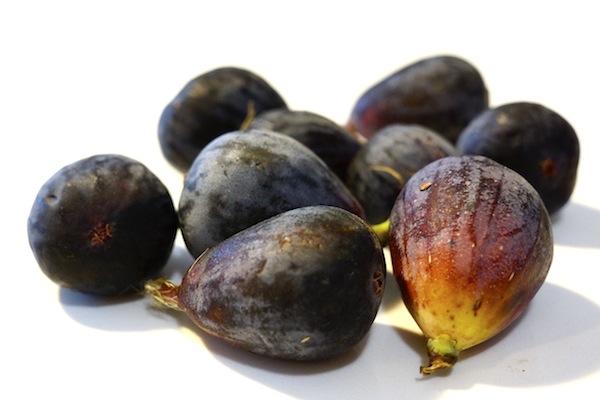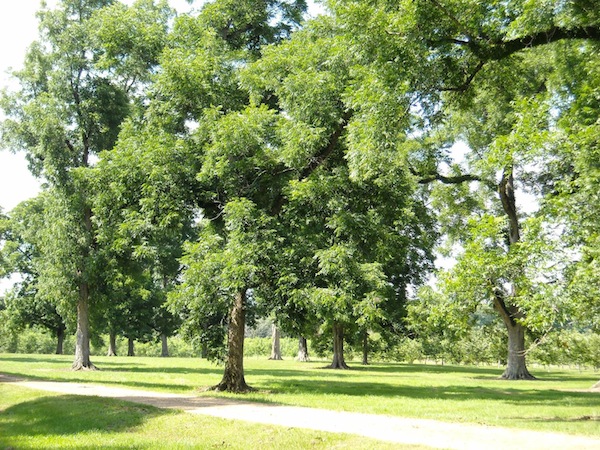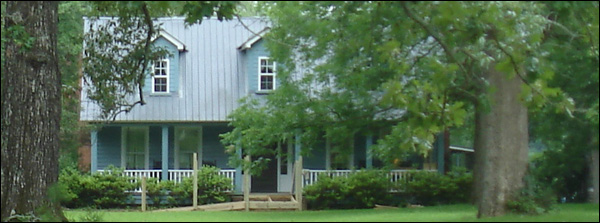Fruit of the Trees of Knowledge, Good & Evil
“I cannot think of a more-utilized product grown on the farm than the pecans. I am absolutely crazy for them; I use them in almost everything. I put them in breads; on salads; in pasta; on cheesecake; in a butter sauce over green beans; in a crust on fish. I make a killer Hoppin’ John each New Year, and it would be only half as good without my pecans. I make stuffed collards instead of cabbage, and I use pecans in the filling. I put pecans in my rice.” William A. Balk, Jr
Epicurus’ Porch
By William A. Balk, Jr.

 BEAUFORT South Carolina—(Weekly Hubris)—10/28/2013—The figs this year were both more plentiful and much fatter and juicier than usual. Last year was a good year, too, but we had so many this year that it’s been hard to use them all before they started getting moldy. Ours are old-fashioned Brown Turkey figs, from a cutting shared by a long-ago neighbor; the tree now some 15 feet tall and 20 feet wide. A handsome tree, even had it never borne fruit, which is certainly not the case.
BEAUFORT South Carolina—(Weekly Hubris)—10/28/2013—The figs this year were both more plentiful and much fatter and juicier than usual. Last year was a good year, too, but we had so many this year that it’s been hard to use them all before they started getting moldy. Ours are old-fashioned Brown Turkey figs, from a cutting shared by a long-ago neighbor; the tree now some 15 feet tall and 20 feet wide. A handsome tree, even had it never borne fruit, which is certainly not the case.
My nephew and his new bride want a fig tree for their new house in Charleston, so I’ve taken a couple of cuttings and have them rooting in pots by the back door. They seem to have set root, and I now watch as the new leaves emerge, bigger each day. The old tree will continue its life in slightly foreign soil, fruitfully bringing sweet pleasure to yet another family.
Recipes for fresh figs, especially milder-tasting varieties such as Brown Turkey, are sometimes hard to come by. My favorite fig recipe is for cake-like cookies filled with fig paste—sort of home-made Fig Newtons, only better—but this recipe, like so many others, calls for dried figs. I did find a recipe for a fig cake using fresh figs, which I tried. The result was an extremely dense, far-too-moist cake, the result of the very high proportion of water in fresh figs. I may try the recipe again, first cooking some of the water off the figs. I must say that, even considering the dubious texture and density of the original recipe, the resulting mush-cake did have fantastic taste. Now that the fresh fig season has ended, I’m encouraged to use dried figs once again in some new recipes.
There was a good crop of blueberries this year, as well. We have just a couple of bushes of several varieties; they’re early, mid-season, and late-producing, so we’re able to pick berries over a good long period. As with most of the fruit we grow, there’s the matter of how much we must share with the resident wildlife, but it usually works out pretty well. The blueberries go into breads, muffins, and pies; into jams and sauces; over ice-cream; into fruit salads. Some of the bounty we freeze in small packages and use all year, often in smoothie drinks.
I refuse to talk much about the pears this year.
The early spring-like weather brought them into full bloom only to be zapped by sudden frosts. Very few fruit on the trees survived that trauma, although, over the last few weeks, I did notice a couple of decent pears hanging from the branches. Even those very, very green pears have now been nibbled by the squirrels, found wanting, and thrown to the ground. So . . . not one pear this year.
It’s disappointing not to have the usual bushels of pears to work with. In the past, we’ve canned dozens of jars of them for winter use. Last year, I baked giant pies filled to overflowing with the pears, froze a couple, and all were very hungrily consumed. I’ll miss those pears this year. My old friend from grammar school days, Joan, has quite generously offered me the chance to gather as many pears as I want from her old Kiefer pear tree downtown. I may have to bake a couple of those huge over-filled pear pies I made last year and put them in the freezer for mid-winter ecstasy.
Basically, I used an apple pie recipe, substituting the pears; the pears get cooked down to rid them of moisture and, because they’re these hard pears, they still retain their sliced shape and some firmness. I use standard apple pie spicing, but I love to add a good dollop of Poire William liqueur to cook down with the other juices. A tablespoon or so of that wonderful pear liqueur in the liquid ingredients for the pie crust makes for a flakier crust, too.
I have a number of pie dishes but, for large festive pies, I like to use a wonderful stoneware dish that seems about twelve inches across—it’s huge! Depending on the pears, it takes most of a peck of fruit to over-fill to perfection.
Forget apples. That forlorn tree is coming down. Crabapples? Although there was a respectable crop of crabapples on the trees this year, those too have been pretty well decimated by the plum curculio worm. Those that escaped worm damage face depredation from the squirrels as they redden, so I don’t expect much. These crabapples do make the most scrumptious jelly, so I will regret not having any of them this year.
Ages ago, I got a couple of quince trees—the fruiting quince, Cydonia oblonga, not the flowering quince, Chaenomeles sp.—to see how they’d do here. Not so well, it turns out, although it may have to do with their having been mowed to the ground a couple of times and chewed to nubs by deer some seasons. But the fruit is reputedly so wonderfully fragrant, so amazingly delicious in jellies, I felt I should try. So those two struggling quince trees slowly add on a few inches each year, making a few flowers but no fruit. Eventually, perhaps, there will be quince jelly to share.

It’s still too early to know how the pecan trees will do. The years we have a bumper crop are joyous ones both for us and for the wildlife. There are two dozen pecan trees around the old farmhouse; the young ones have been here for half a century; the giants closest to the house, much longer. Some were planted for the quality of their nuts; some are seedlings of those more glamorous parents, sprung up where a foothold was found.
The very best of these pecans is the one in the field near the old cemetery in the pines. This big old tree spreads its handsome limbs nearly 50 feet across. Its nuts, however, are quite small—about the size of the last joint on my thumb—and quite hard-shelled. They’re not that easy to shell, but are absolutely packed with flavor. And this is one of those seedling trees, of mixed parentage, completely lacking in the carefully-bred-for characteristics of size and ease of shelling. A mongrel. and a prized tree, indeed.
I cannot think of a more-utilized product grown on the farm than the pecans. I am absolutely crazy for them; I use them in almost everything. I put them in breads; on salads; in pasta; on cheesecake; in a butter sauce over green beans; in a crust on fish. I make a killer Hoppin’ John each New Year, and it would be only half as good without my pecans. I make stuffed collards instead of cabbage, and I use pecans in the filling. I put pecans in my rice. If I’m serving ice cream, I toast and chop some pecans to sprinkle over it. I love my pecans!
There are two grape arbors with both muscadines and scuppernongs on them. The year before my father died, he was proudly watching over his developing crop of grapes. Each week, when I’d visit, I’d check on their progress, and we’d speculate about how much longer it’d be before they were ready to pick.
One weekend, I drove up to the farm and went over to the arbor for the grapes I was certain would be absolutely ready for picking. Not one grape on the vines! Not one! I went in to my father to ask when he’d picked them. He was quite surprised—he hadn’t picked them yet. Someone—someone—had crept up overnight and stolen every single muscadine. We spent the day trying to decide who could have been so rude.
I went home after the weekend, thought a great deal about this theft, and began to search the internet for clues. After a couple hours of aimless Googling, I came across photographs of a big deer that had been shot. In the process of dressing the deer, after making the cut to remove the viscera, one photo showed the contents of its gut: nearly a bushel of ripe muscadines: whole, purple and unmistakable.
Mystery solved; it was the deer that had consumed every one of my father’s prized grapes in the space of one night. If it ain’t the squirrels, it’s the deer. Nothing is safe in the country.
There certainly was no muscadine wine made at our house that year.
![]()
Recipe
Newtonian Fig Cookies
Dough:
Wet Ingredients:
1/3 cup vegetable shortening
1 cup packed brown sugar
2 eggs
1 teaspoon vanilla extract
Dry Ingredients:
1 1/4 cups all-purpose flour
1 1/4 cups whole-wheat flour (or all-purpose flour)
1/4 teaspoon baking soda
2 teaspoons baking powder
1 teaspoon grated orange peel
pinch of salt
Fig Filling:
1 (8oz) package dried figs, stems removed
2/3 cup water
Zest of one lemon or orange (or 3 Tablespoons juice of lemon or orange)
1 stick cinnamon
3 tablespoons granulated sugar
Egg wash
In a large bowl, cream together shortening, brown sugar, eggs, and vanilla until smooth. Add all-purpose flour, whole-wheat flour, baking soda, baking powder, orange peel, and salt, beating until blended. Refrigerate dough at least 1 hour.
Prepare Fig Filling: In a medium saucepan, combine figs, water, lemon or orange peel, and granulated sugar. Bring to a boil over medium heat, stirring occasionally. Reduce heat and simmer 5 to 10 minutes or until thickened, stirring occasionally. Cool and set aside. When cooled, first remove zest and cinnamon; pour figs and juices into bowl of a food processor. Purée and set aside.
To fill and bake cookies, preheat oven to 375F (190C). Grease baking sheets. On a floured surface, roll dough into a 14-inch square. Cut dough into 4 equal strips, each 14 inches long and 3 1/2 inches wide. Return to refrigerator for 15 or 20 minutes.
Fill a pastry bag with the filling, using a large round tip. Retrieve the cooled, firm strips from the refrigerator; squeeze a full, plump stripe of Fig Filling down the center of each strip, using ¼ of the total amount for each strip. With a pastry brush, paint one side of each strip with egg wash to help seal the cookie when folded over itself. Using a long spatula, lift sides of each dough strip over filling, overlapping slightly on top. Press edges together to seal. Cut strips crosswise in half for ease in handling. Place, seam-side down, 3 inches apart on parchment-covered baking sheets. Brush off any excess flour. Cut each strip into 7 (1-inch) crosswise pieces, but do not separate. Bake 13 to 15 minutes or until puffed and firm to the touch. Cool 5 to 10 minutes on baking sheets; then cut apart and remove to racks to cool completely. Makes about 56 (2” x 1”) cookies.
![]()
Note: The image of figs derives from http://www.endlesssimmer.com/2012/09/05/put-it-in-a-jar-fig-jam/; that of Southern pecan trees, from http://msfruitextension.wordpress.com/category/pecans/.
Note: This essay was adapted from a column Will wrote for Lowcountry Weekly: Reflections on the good life in coastal South Carolina (http://www.lcweekly.com/), where he serves as a regular contributor.

17 Comments
Dana Wildsmith
I love when a blog- like a good poem- contains a line that makes me hurry to write it down, all the while wishing I had said it in just that way. In the case of this post, it was, “I refuse to talk much about the pears.” Don’t you just love how that straightforward wording sings with the betrayal and hurt all gardeners feel when we are denied our just harvest? I, myself, have refused to talk about the muscadines after they promised so much and gave so little. Perhaps they, too, were the victims of deer?
Will Balk, Jr
Dana, I suspect in your case the culprit may have been Don! BTW, I did go by my friend Joan’s finally, and I managed to get the last pears of the season from her tree downtown. Not enough to do one of my giant pies, but they make a killer breakfast treat for Mama (and me!) when I fry the slices up in a little butter, maple syrup, and cinnamon.
gary geboy
We have nothing to fear from the zombies threatening the peace or those clowns in Washington. It’s those damn squirrels!
Debbie Hayes
Great story of the tree, vine, and bush! I was just saying to my daughter, that as a South Carolina native of at least ten generations, I can hardly cook a dish without pecans or nuts. I envision your Mother’s lovely farm in this story as a place of peace and love. How blessed you all are.
Debbie H.
lolita
loved the ENTIRE column but the comment about pecan trees really “hit home.” last year, our trees in North Carolina were prolific…this year…not a nut to be seen. since Mom passed, the earth seems less productive but I suspect, as time passes, things will “look up.” there’s always next year!
Will Balk, Jr
Debbie, you always make me doubly appreciative of the wonderful readers who make an effort to comment here. Thank you so much for bringing your own insights to bear.
Will Balk, Jr
Lolita, you know how much I’ve enjoyed and appreciated your writing over decades now. Thank you, thank you for taking a few moments to read my freshman efforts. I know how much losing your mother has meant to you; I know well the sense of the earth’s apparent barrenness on the death of a loved one. And we both do know that the one thing to count on about Nature is that things will be different next year – maybe not in the way we want or the way we expect, but different certainly. Between despair and hope – for each seems equally valid – I go with hope!
jenks
Well, you had plenty to say about pears not long ago and that conversation spurred me to plant 7 sand pears and one asian pear. thanks!
Elizabeth Boleman-Herring
Will, as Diana Farr Louis will confirm, one of the most heavenly Greek desserts is one of the most simple: two very fresh, sweet, succulent walnut halves tucked into a dried fig. Greece has the most astonishing figs, fresh and dried-in-sugar, I’ve ever tasted, though I’m sure there are places in Anatolia and elsewhere in The Levant that compete with Hellas. Still . . . that was my favorite of all desserts, in winter, in Greece. Accompanied by a small glass of 7-Star Metaxa.
Will Balk, Jr
Gary, you know well the depredations wrought by the squirrely vermin. I may take your advice and go on Halloween dressed as the vilest scary creature, the squirrel!
Will Balk, Jr
Jenks, I know Miss Gloria will be most appreciative of the bounty from those trees. And I love the addition of the Asian pear among the others. I may follow your lead.
Will Balk, Jr
EBH, I go crazy for the dried fruits stuffed with nuts! Figs and walnuts, of course. Apricots and almonds. And I needn’t mention my readiness to put a pecan where any other nut has been suggested.
I take it that the Metaxa is an inseparable part of the dessert experience?
Linda Christine
Gloria Farmer has some good recipes using figs and recently made a great cobbler using pears and maybe Tom’s honey…she is a great cook and wonderful hostess.
Elizabeth Boleman-Herring
Will, the 7-Star’s an acquired taste. We’ll bring some South next time. It’s the soft, sugar-coated Greek figs AND the dry, dry Metaxa that make it all work…..
Will Balk, Jr
Linda, I certainly am not surprised at all that Gloria’s an accomplished cook…I had recently some delightful deviled eggs she made with her fabulous bantam eggs. That she bakes as well – I guess I have lots more to look forward to!
Will Balk, Jr
EBH – now to locate some of those Greek figs!
diana
Hi Will, am madly jealous about all those pecans. We never see them here and if we do, they’re way too expensive to do anything with. Our pecan pies have walnuts in them. But concerning figs, this w/e I stuffed some chicken breasts with chopped dried figs and chopped green olives, & a few croutons after marinating them all night with what should have been Metaxa and orange juice. Used some not so good Calvados instead and that worked fine. Will add a bit of spice next time, some chilli pepper flakes, but even so it was delicious. Saute first and then bake for 15 mins. I’m not too big on desserts but do admire your talent for pies. And I will not talk about my apricots, so there. Though I must say you have far more predators than we have in Greece.